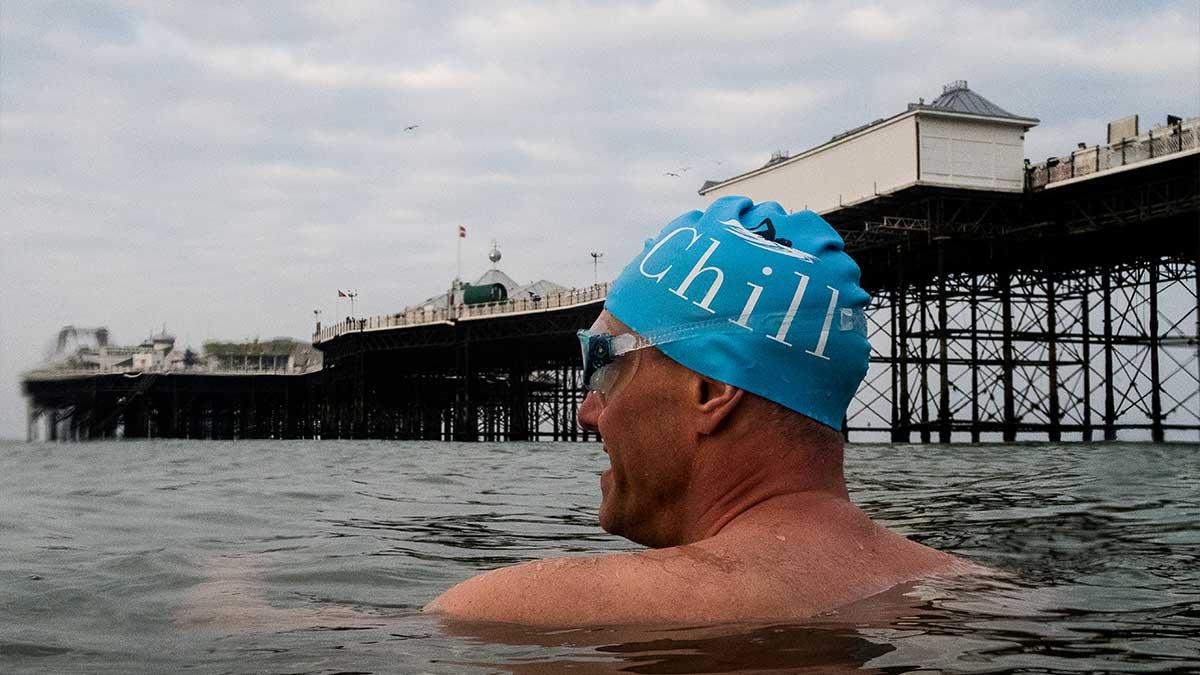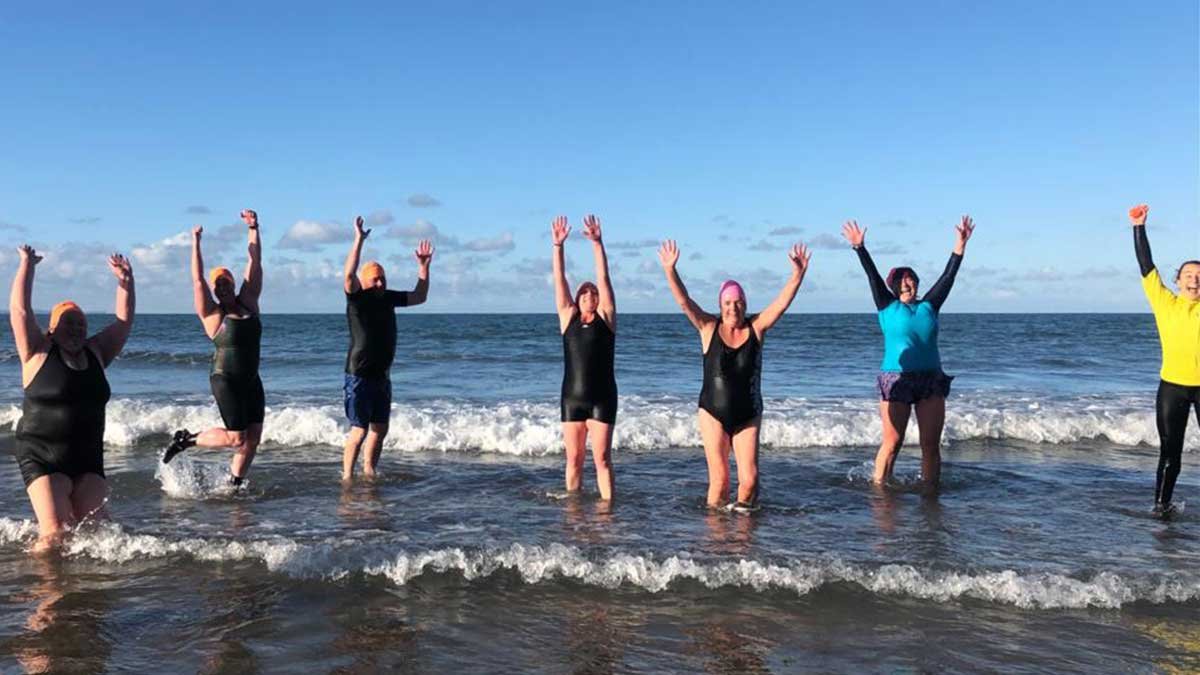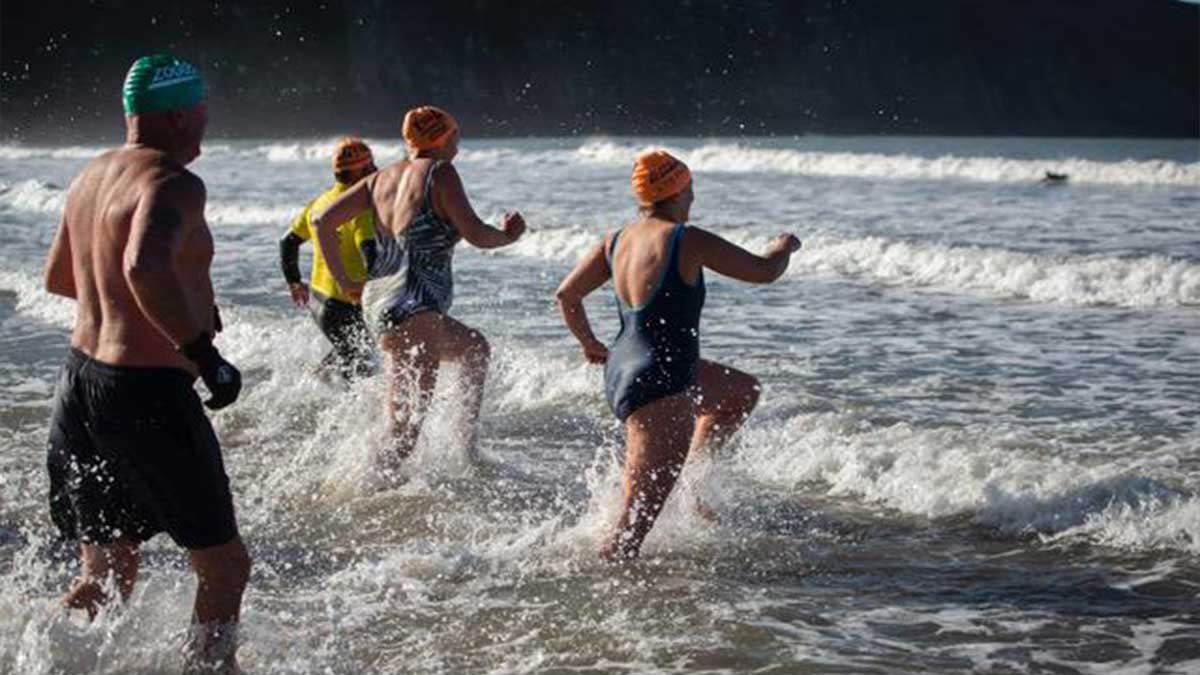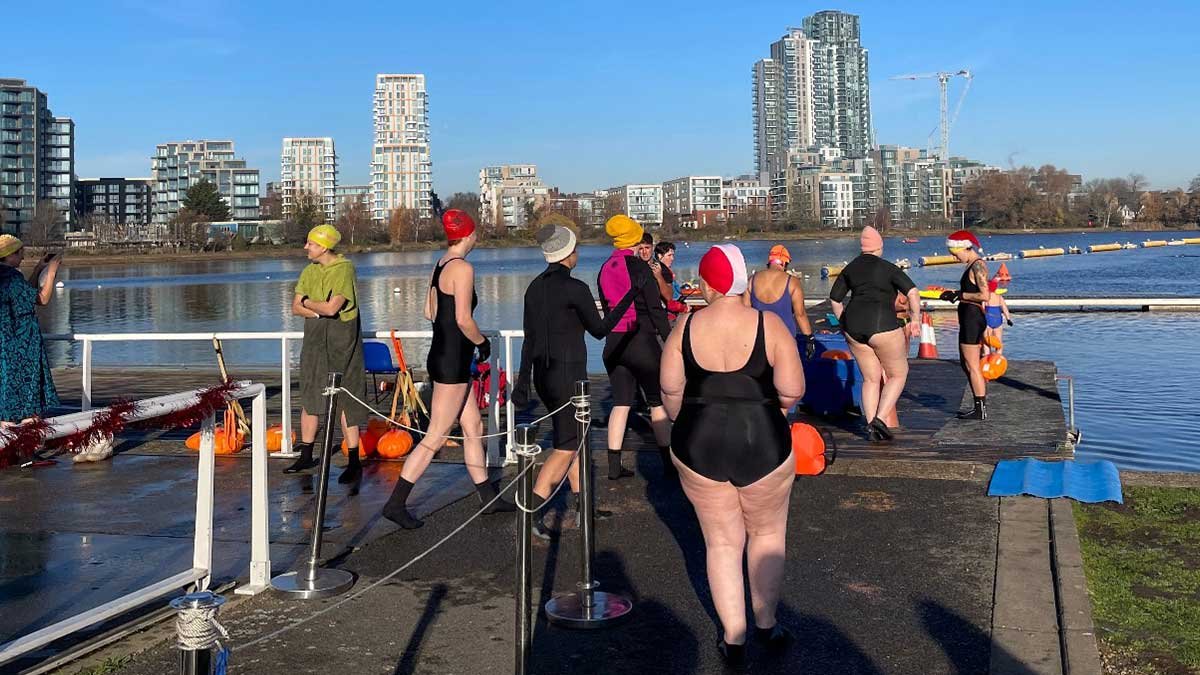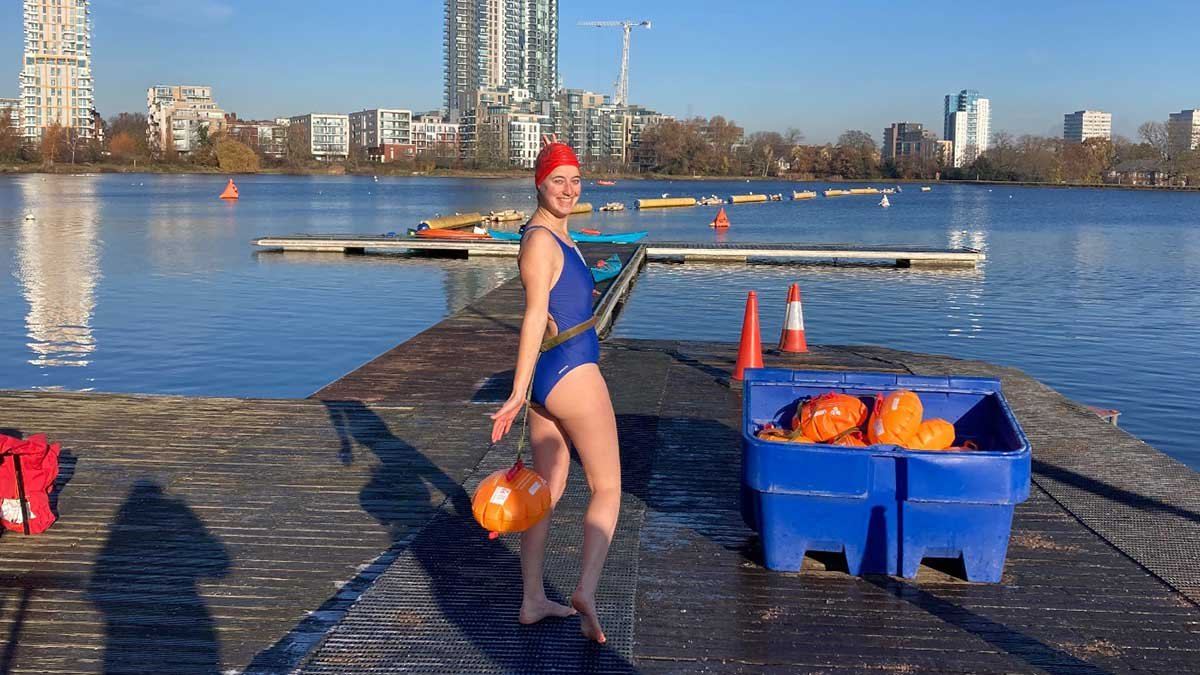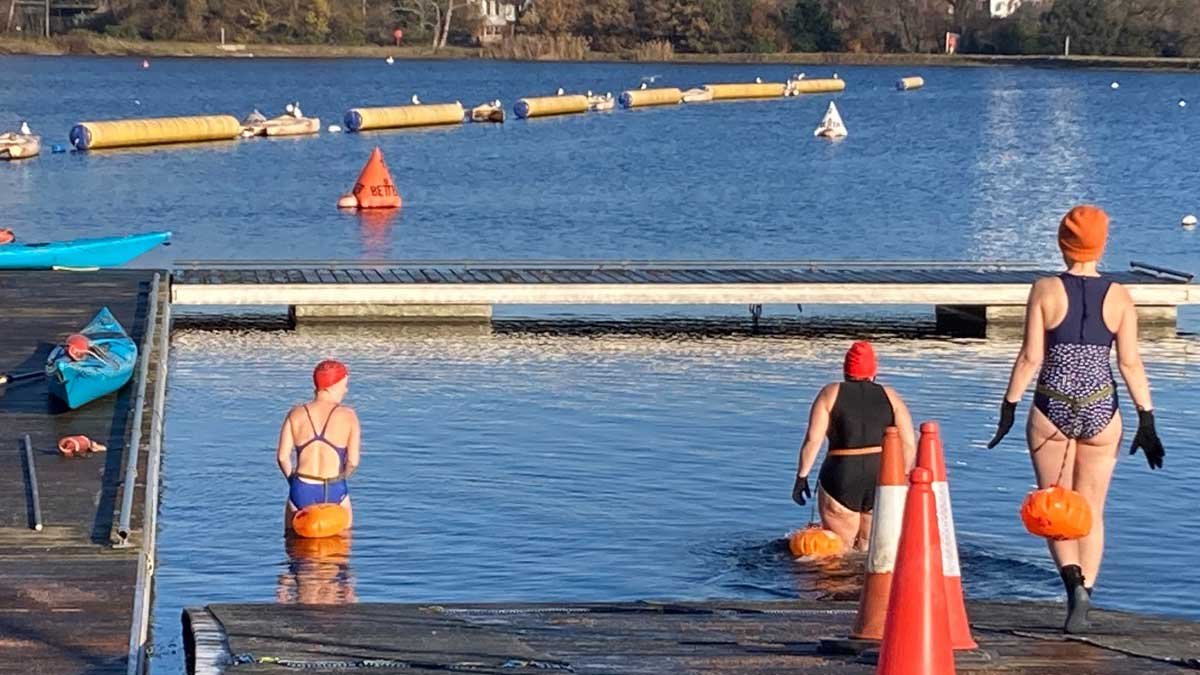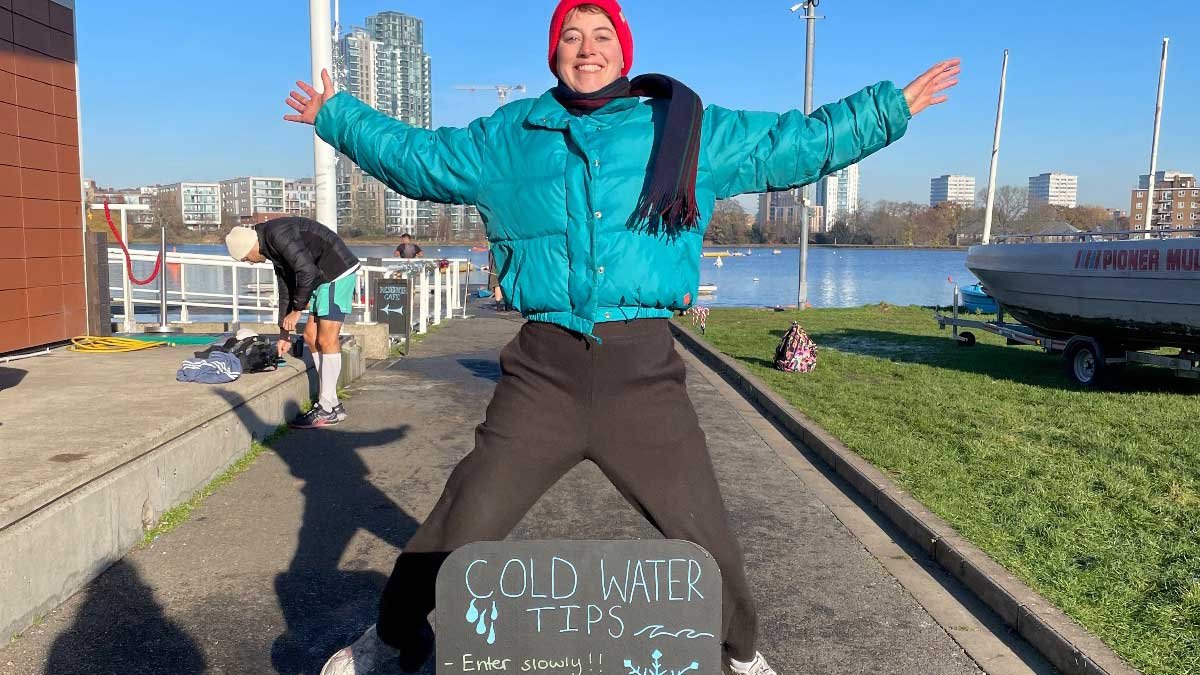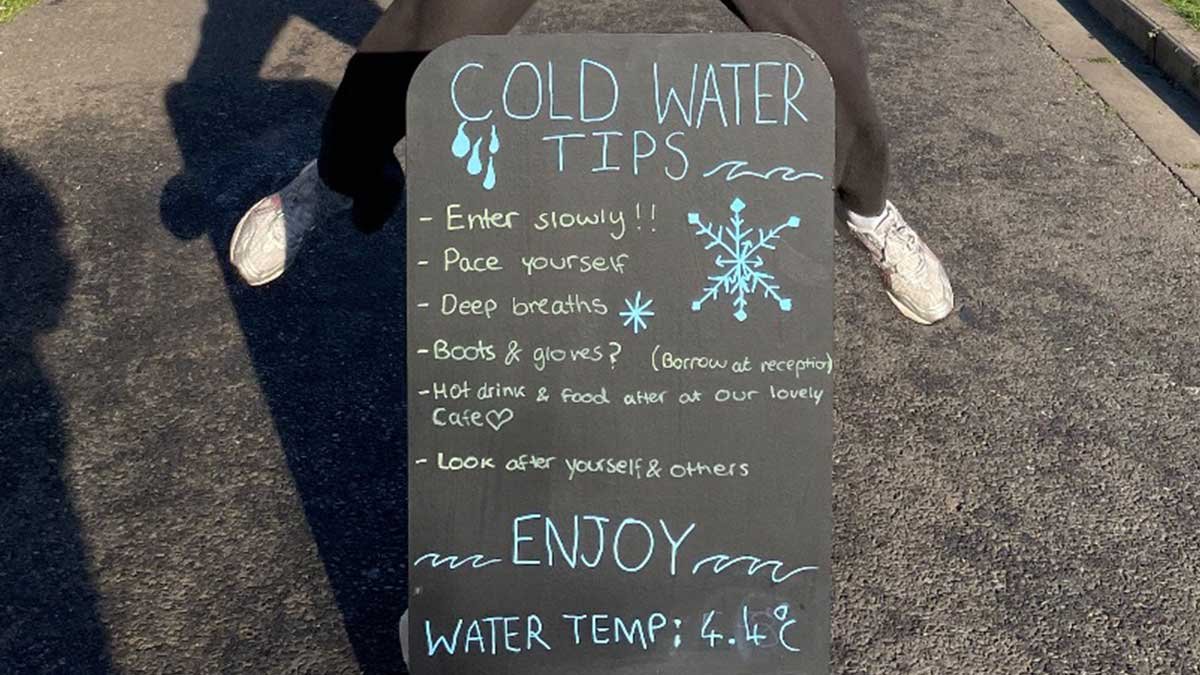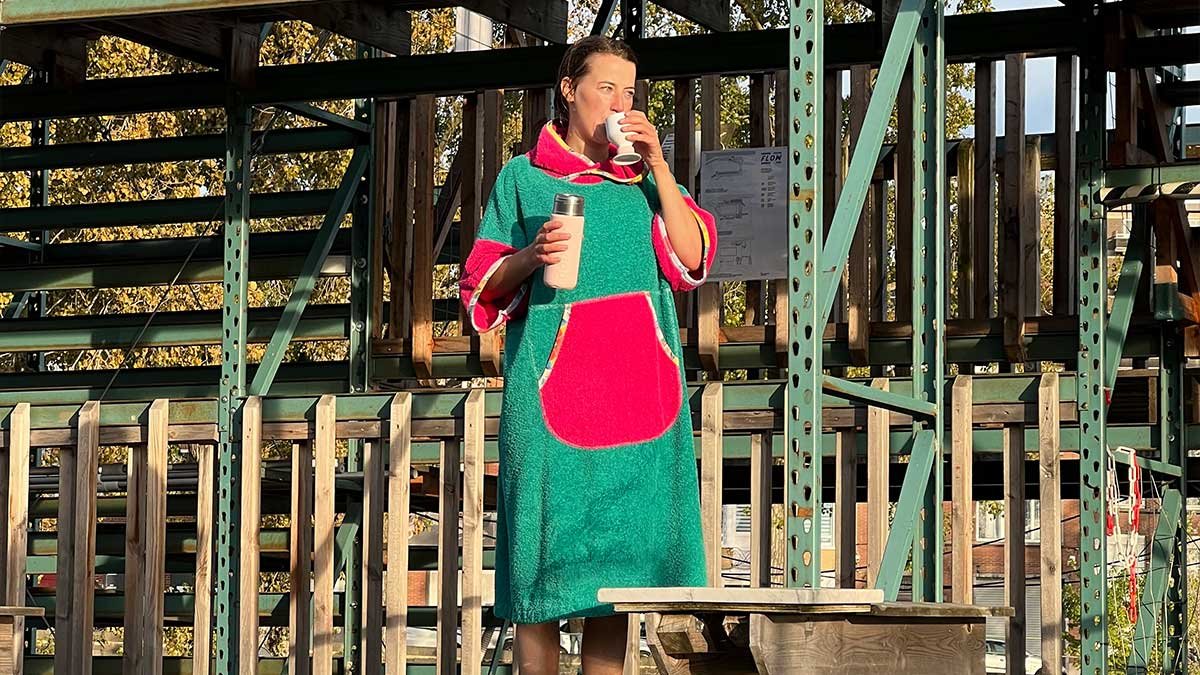7 TIPS FOR WINTER SWIMMING
EN
HOW TO SWIM THROUGH THE WINTER AT FLOW - 7 TIPS
Anaesthetist and researcher Dr Mark Harper remembers 20 years later exactly how he felt after going winter swimming for the first time: 'I had so much energy and that energy felt so pure.' What started as swimming in the sea with a friend once when the pool in Brighton temporarily closed, turned into 20 years of passionate winter swimming, scientific research into its health benefits and the recent publication of his book: 'Chill, The Cold Water Swim Cure'. Sofie Neven spoke to him to share his tips for those looking to brave the winter waters at FLOW in Brussels.
Before we start, can anyone do winter swimming?
You should compare winter swimming with intensive training. If you have heart problems, poorly controlled high blood pressure, are pregnant or generally unsure about your fitness then it's best to consult a doctor before you start.
1 - What do you take with you?
A towel to dry yourself off, and possibly a second one to stand on after swimming.
Swimwear. Best put them on already under your clothes.
Flip-flops. Not necessary, but they make walking on the wooden decks of FLOW more comfortable.
Warm clothes that you can easily put on after swimming. This can be, for example, a jogging, thick sweater and jacket. The fewer buttons or zips on your clothes, the easier it is to put them on with cold hands. There are also ponchos or 'changing robes'. The latter is a kind of bathrobe that keeps you warm and is large enough to change underneath.
A hat, neoprene gloves and shoes: these will help you avoid cold hands, feet and head. This is not a must but comfortable.
Hot drink: tea will be provided for everyone at FLOW, but feel free to bring a thermos of your favourite drink too.
2 - Before entering the water: warm up physically
Warm up your body from the inside out by exercising. That way, your body will cool down less quickly in the water than if you don't physically warm up. For example, you can cycle or jog to the pool or warm up around the pool itself.
3 - Enter the water gently: first with your body, then with your head
Enter the water gradually via the ladders of the pool, do not jump into the water.
4 - Focus on your breathing
If you are not used to winter swimming, when you enter the water your body will automatically inhale deeply, followed by rapid breathing and/or hyperventilation. Within 2 to 3 minutes, your breathing naturally returns to normal. At that point, you have already experienced most of the benefits of winter swimming. As a beginner, you can get out of the water at this point. There is no need to stay in the water as long as possible to benefit from the positive effects of winter swimming. About 80% of the benefits are already experienced in the first five minutes.
Those who have been swimming in cold water for longer can stay longer and know their limits better. The most important thing is to keep it fun. After your breathing is under control, you can also dip your face under water three times for two or three seconds. This stimulates the parasympathetic nervous system which provides a relaxed feeling and can reduce inflammation.
5 - Make your swimming experience as pleasant as possible
At water temperatures below 10 degrees, Mark recommends a warm hat, neoprene gloves and shoes. This makes it comfortable and ensures you don't suffer from cold hands, feet and head.
6 - Dry off and warm up
As soon as you get out of the water, dry yourself off, shelter yourself from the wind and put on warm clothes. Also lay out these clothes before you enter the water. Depending on how long you have been in the water, it is good to warm up afterwards with some physical exercises. At FLOW, there are no showers in winter, but this is not necessary, on the contrary: an immediate hot shower can lead to a sudden drop in blood pressure, which can cause you to faint. To get warmed up again, we do offer hot drinks, much better and cozier!
7 - Enjoy the feeling
Enjoy the energetic feeling, the social aspect of winter swimming and the wonderful outdoors! Have a hot drink together and share your experience. At home, feel free to take a warm shower. Start with lukewarm water and gradually increase the temperature when you feel your skin feels good. Don't start with a hot shower right away, as the cold may make your skin a bit numb and you may not notice that the water is too hot and so you may burn yourself.
Want to know more about science-based benefits of winter swimming? In his book: 'Chill, The Cold Water Swim Cure', Mark mixes science with case studies and patient stories on how cold water can affect us physiologically and mentally for conditions such as depression, anxiety, chronic pain, migraines and more. He also shares lots of practical tips for those keen to start winter swimming.
Also check out this article on our website from 2017! Back then, we were already dreaming of a place for winter swimming in Brussels and looked at the effects on body and health.
FR
COMMENT NAGER PENDANT L'HIVER À FLOW - 7 CONSEILS
Dr Mark Harper, anesthésiste et chercheur, se souvient exactement, 20 ans plus tard, de ce qu'il a ressenti après avoir pratiqué la natation hivernale pour la première fois : "J'avais tellement d'énergie et cette énergie me paraissait si pure." Ce qui a commencé par une baignade en mer avec un ami lorsque la piscine de Brighton était temporairement fermée, s'est transformé en 20 ans de natation hivernale passionnée, de recherche scientifique sur ses bienfaits pour la santé et de publication récente de son livre : 'Chill, The Cold Water Swim Cure'. Sofie Neven s'est entretenue avec lui pour qu'il partage ses conseils avec ceux qui cherchent à braver les eaux hivernales à FLOW à Bruxelles.
Avant de commencer, est-ce que tout le monde peut faire de la baignade en hiver ?
Tu dois comparer la natation hivernale à un entraînement intensif. Si tu as des problèmes cardiaques, une hypertension artérielle mal contrôlée, si tu es enceinte ou si tu n'es pas sûre de ta forme physique, il est préférable de consulter un médecin avant de commencer.
1 - Qu'est-ce que tu emportes avec toi ?
Un essuie pour te sécher, et éventuellement une deuxième pour te tenir debout après avoir nagé.
Des maillots de bain. Le mieux est de les mettre déjà sous tes vêtements.
Claquettes. Elles ne sont pas nécessaires, mais rendent la promenade sur les terrasses en bois de FLOW plus confortable.
Des vêtements chauds que tu peux facilement mettre après la baignade. Il peut s'agir par exemple d'un jogging, d'un pull épais et d'une veste. Moins il y a de boutons ou de fermetures éclair sur tes vêtements, plus il est facile de les enfiler avec les mains froides. Il existe également des ponchos ou des „canging robes". Ce dernier est une sorte de peignoir qui te tient chaud et qui est assez grand pour que tu puisses te changer en dessous.
Un bonnet, des gants en néoprène et des chaussures : ils te permettront d'éviter d'avoir froid aux mains, aux pieds et à la tête. Ce n'est pas indispensable mais c'est confortable.
Une boisson chaude : du thé sera fourni à tout le monde à FLOW, mais n'hésite pas à apporter aussi un thermos de ta boisson préférée.
2 - Avant d'entrer dans l'eau : réchauffe-toi physiquement.
Réchauffe ton corps de l'intérieur en faisant de l'exercice. Ainsi, ton corps se refroidira moins vite dans l'eau que si tu ne t'échauffes pas physiquement. Par exemple, tu peux faire du vélo ou du jogging jusqu'à la piscine ou t'échauffer autour de la piscine elle-même.
3 - Entre dans l'eau doucement : d'abord avec ton corps, puis avec ta tête
Entre dans l'eau progressivement par les échelles de la piscine, ne saute pas dans l'eau.
4 - Concentre-toi sur ta respiration
Si tu n'as pas l'habitude de nager en hiver, lorsque tu entres dans l'eau, ton corps va automatiquement inspirer profondément, suivi d'une respiration rapide et/ou d'une hyperventilation. Au bout de 2 à 3 minutes, ta respiration revient naturellement à la normale. À ce moment-là, tu as déjà expérimenté la plupart des avantages de la natation hivernale. En tant que débutant, tu peux sortir de l'eau à ce stade. Il n'est pas nécessaire de rester dans l'eau le plus longtemps possible pour bénéficier des effets positifs de la natation hivernale. Environ 80 % des bénéfices sont déjà ressentis dans les cinq premières minutes.
Ceux qui nagent dans l'eau froide depuis plus longtemps peuvent rester plus longtemps et connaissent mieux leurs limites. Le plus important, c'est de garder le plaisir. Après avoir maîtrisé ta respiration, tu peux aussi plonger ton visage sous l'eau trois fois pendant deux ou trois secondes. Cela stimule le système nerveux parasympathique qui procure une sensation de détente et peut réduire l'inflammation.
5 - Rends ton expérience de la natation aussi agréable que possible.
Lorsque la température de l'eau est inférieure à 10 degrés, Mark recommande de porter un bonnet chaud, des gants en néoprène et des chaussures. Cela permet d'être à l'aise et de ne pas souffrir de mains, de pieds et de tête froids.
6 - Sèche-toi et réchauffe-toi
Dès que tu sors de l'eau, sèche-toi, abrite-toi du vent et enfile des vêtements chauds. Étends également ces vêtements avant d'entrer dans l'eau. Selon le temps que tu as passé dans l'eau, il est bon de t'échauffer ensuite avec quelques exercices physiques. Chez FLOW, il n'y a pas de douches en hiver, mais ce n'est pas nécessaire, au contraire : une douche chaude immédiate peut entraîner une chute brutale de la pression artérielle, ce qui peut provoquer un évanouissement. Pour te réchauffer, nous te proposons en revanche des boissons chaudes, bien meilleures et plus douillettes !
7 - Profite des sensations
Profite de la sensation d'énergie, de l'aspect social de la natation hivernale et de la merveilleuse atmosphère qui règne en plein air ! Prenez une boisson chaude ensemble et partagez votre expérience. À la maison, n'hésite pas à prendre une douche chaude. Commence par de l'eau tiède et augmente progressivement la température lorsque tu sens que ta peau se sent bien. Ne commence pas tout de suite par une douche trop chaude, car le froid risque d'engourdir un peu ta peau et tu ne remarqueras peut-être pas que l'eau est trop chaude et tu risquerais donc de te brûler.
Tu veux en savoir plus sur les avantages scientifiques de la baignade hivernale ? Dans son livre : "Chill, The Cold Water Swim Cure", Mark mélange la science avec des études de cas et des histoires de patients sur la façon dont l'eau froide peut nous affecter physiologiquement et mentalement pour des conditions telles que la dépression, l'anxiété, la douleur chronique, les migraines et plus encore. Il partage également de nombreux conseils pratiques pour ceux qui souhaitent commencer à nager en hiver.
Découvre aussi cet article sur notre site web datant de 2017 ! À l'époque, nous rêvions déjà d'un lieu pour la natation hivernale à Bruxelles et nous nous sommes penchés sur les effets sur le corps et la santé.
NL
Zo zwem je de winter door bij FLOW - 7 tips
Anesthesist en onderzoeker Dr. Mark Harper weet 20 jaar later nog exact hoe hij zich voelde nadat hij de eerste keer ging winterzwemmen: ‘Ik had zoveel energie en die energie voelde zo puur.’ Wat begon als een keer mee zwemmen in zee met een vriend toen het zwembad in Brighton tijdelijk sloot, draaide uit tot 20 jaar gepassioneerd winterzwemmen, wetenschappelijk onderzoek naar de gezondheidsvoordelen ervan en de recente uitgave van zijn boek: ‘Chill, The Cold Water Swim Cure’. Sofie Neven sprak met hem om zijn tips te delen voor wie de winterse wateren wil trotseren in FLOW in Brussel.
Voor we starten, kan iedereen winterzwemmen?
Vergelijk het winterzwemmen gerust met een intensieve training. Heb je hartproblemen, een slecht gecontroleerde hoge bloeddruk, ben je zwanger of in het algemeen onzeker over je conditie dan raadpleeg je best een arts voordat je begint.
1 - Wat neem je mee?
Een handdoek om je af te drogen, en eventueel een tweede om op te staan na het zwemmen.
Zwemkledij. Doe ze best al aan onder je kleren.
Slippers. Niet noodzakelijk, maar ze maken het lopen op de houten vloeren van FLOW comfortabeler.
Warme kleding die je makkelijk kan aantrekken na het zwemmen. Dit kan bijvoorbeeld een jogging, dikke pull en jas zijn. Hoe minder knopen of ritsen aan je kleding, hoe makkelijker je deze met koude handen kan aandoen. Er bestaan ook poncho’s of ‘changing robe’. De laatste is een soort van omkleedjas die je warm houdt en groot genoeg is om je eronder om te kleden.
Een muts, neoprene handschoenen en schoenen: hiermee vermijd je koude handen, voeten en hoofd. Dit is geen must maar aangenaam.
Warme drank: er wordt thee voorzien voor iedereen aan FLOW, maar breng gerust ook een thermos met je lievelingsdrank.
2 - Voor je in het water gaat: warm je fysiek op
Warm je lijf van binnenuit op door te sporten. Zo koelt je lichaam minder snel af in het water dan wanneer je je niet fysiek opwarmt. Je kan bijvoorbeeld met de fiets of al joggend naar het zwembad komen of rond het zwembad zelf opwarmen.
3 - Ga rustig het water in: eerst met je lijf, dan met je hoofd
Ga geleidelijk het water in via de ladders van het zwembad, spring niet in het water.
4 - Focus op je ademhaling
Wanneer je niet gewoon bent om te winterzwemmen, zal je lichaam bij het betreden van het water automatisch diep inademen, gevolgd door een snelle ademhaling en/of hyperventilatie. Binnen 2 à 3 minuten keert je ademhaling vanzelf terug naar normaal. Op dat punt heb je al de meeste voordelen van winterzwemmen ervaren. Als beginner kan je op dit moment uit het water gaan. Het is niet nodig om zo lang mogelijk in het water te blijven om te profiteren van de positieve effecten van winterzwemmen. Ongeveer 80% van de voordelen wordt al ervaren in de eerste vijf minuten.
Wie al langer in koud water zwemt, kan langer blijven en kent zijn of haar grenzen beter. Het belangrijkste is om het leuk te houden. Nadat je ademhaling onder controle is, kan je je gezicht ook drie keer twee of drie seconden onder water dompelen. Dit stimuleert het parasympathische zenuwstelsel dat voor een ontspannen gevoel zorgt en kan ontstekingen verminderen.
5 - Maak je zwemervaring zo aangenaam mogelijk
Bij watertemperaturen onder de 10 graden raadt Mark een warme muts, neoprene handschoenen en schoenen aan. Dit maakt het aangenaam en zorgt ervoor dat je geen last hebt van koude handen, voeten en hoofd.
6 - Afdrogen en opwarmen
Droog je zo snel mogelijk af zodra je uit het water komt, beschut je van de wind en doe warme kleding aan. Leg deze kleding ook al klaar voor je het water ingaat. Afhankelijk van hoe lang je in het water bent geweest, is het goed om erna op te warmen met enkele fysieke oefeningen. Bij FLOW zijn er geen douches in de winter, maar dit is ook niet nodig, in tegendeel: onmiddellijk heet douchen kan leiden tot een plotselinge daling van de bloeddruk, waardoor je flauw kunt vallen. Om weer opgewarmd te geraken bieden wij wel warme dranken aan, veel beter en gezelliger!
7 - Geniet van het gevoel
Geniet van het energieke gevoel, het sociale aspect van het winterzwemmen en het heerlijk buiten zijn! Drink samen een warm drankje en deel je ervaring. Thuis kan je gerust een warme douche nemen. Begin met lauw water en verhoog geleidelijk de temperatuur wanneer je je huid goed aanvoelt. Start niet meteen met een hete douche, want door de kou kan je huid wat verdoofd zijn en merk je misschien niet dat het water te heet is en zo kan je je verbranden.
Meer weten over wetenschappelijk onderbouwde voordelen van winterzwemmen? In zijn boek: ‘Chill, The Cold Water Swim Cure’ mixt Mark wetenschap met casestudies en verhalen van patiënten hoe koud water ons fysiologisch en mentaal kan beïnvloeden voor aandoeningen als depressie, angst, chronische pijn, migraine en meer. Daarnaast deelt hij ook heel wat praktische tips voor wie graag wil starten met winterzwemmen.
Kijk ook eens naar deze artikel op ons website uit 2017! Toen droomden we al van een plek voor winterzwemmen in Brussel en hebben we de effecten op lichaam en gezondheid bekeken.
SOFIE NEVEN
Sofie Neven is a Brussels-based creative who loves adventure, the outdoors and water lilies. She started winter swimming during corona from a great lack of being able to swim freely. She then photographed and swam with people in lakes and loved being able to experience the beauty of nature that way. Winter swimming helps break through the mundane, dwell on the simple things and makes you feel like you can handle anything. Due to lack of time, she did not swim as much in the cold last year, but now she is very happy to pick it up again at FLOW.
Sofie wrote an article on winter swimming for L'Echo's Sabato magazine.
Sofie Neven est une Bruxelloise créative qui aime l'aventure, le plein air et les nénuphars. Elle a commencé la natation hivernale pendant la corona d'un grand manque de pouvoir nager librement. Elle a ensuite photographié et nagé avec des gens dans des lacs et a adoré pouvoir découvrir la beauté de la nature de cette façon. La natation hivernale permet de sortir de la banalité, de s'attarder sur les choses simples et de se sentir capable de tout affronter. Par manque de temps, elle n'a pas autant nagé dans le froid l'année dernière, mais elle est maintenant très heureuse de reprendre le fil à FLOW.
Sofie a écrit un article sur la natation en hiver pour le magazine Sabato de L’Echo.
Sofie Neven is een creatieve Brusselaar die houdt van avontuur, de outdoors en waterlelies. Zij startte met winterzwemmen tijdens corona vanuit een groot gemis om vrij te kunnen zwemmen. Zij fotografeerde en zwom toen mee met mensen in meren en vond het heerlijk om de schoonheid van de natuur op die manier te kunnen beleven. Winterzwemmen helpt om het alledaagse te doorbreken, stil te staan bij de simpele dingen en geeft je het gevoel dat je alles aankan. Door tijdsgebrek heeft zij het laatste jaar niet zoveel in de koude gezwommen, maar nu is zij héél blij dat ze bij FLOW de draad weer kan oppikken.
Sofie schreef een artikel over winterzwemmen voor het magazine Sabato van De Tijd.

